Fujifilm XC 16-50mm F3.5-5.6 OIS Review
-
Ease
of Use -
Sample
Images -
Lens
Specs -
Rating &
Conclusion -
Main
Rivals -
Review
Roundup - Comment
-
More…

Introduction
The Fujifilm XC 16-50mm F3.5-5.6 OIS is a lightweight, more affordable standard zoom for the X-system. Shipping as the kit lens for the X-M1, the Fujifilm XC 16-50mm F3.5-5.6 OIS offers an angle-of-view similar to that of a 24-76mm lens in a 35mm system. It features an iris diaphragm with seven rounded blades, optical image stabilisation, a high-precision stepping motor, silent operation for video recording, and an optical formula that comprises 12 all-glass elements in 10 groups including 3 aspherical elements and 1 ED element. Available in black or silver, the Fujifilm XC 16-50mm F3.5-5.6 OIS lens costs £359.99 in the UK.
Ease of Use
The Fujifilm XC 16-50mm F3.5-5.6 OIS is a compact and lightweight standard zoom lens, weighing a mere 195g. As you can see in the pictures below, it complements the new Fujifilm X-M1 very well, although it looks a little incongruous when fully zoomed out.
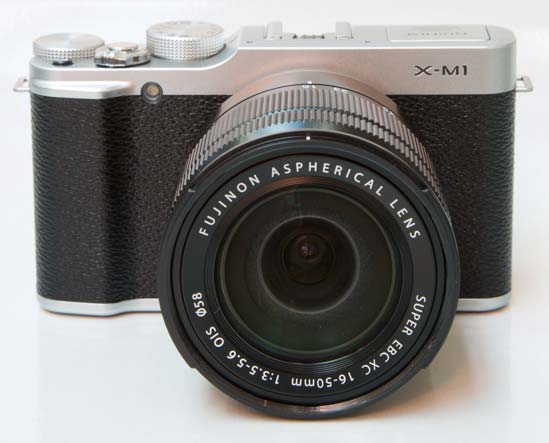 The Fujifilm XC 16-50mm F3.5-5.6 OIS lens attached to the Fujifilm X-M1 camera
The Fujifilm XC 16-50mm F3.5-5.6 OIS lens attached to the Fujifilm X-M1 camera
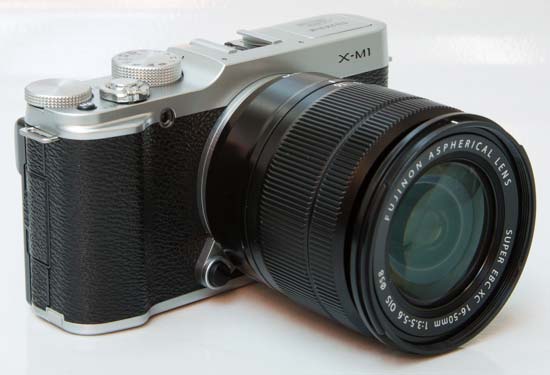 The Fujifilm XC 16-50mm F3.5-5.6 OIS lens attached to the Fujifilm X-M1 camera
The Fujifilm XC 16-50mm F3.5-5.6 OIS lens attached to the Fujifilm X-M1 camera
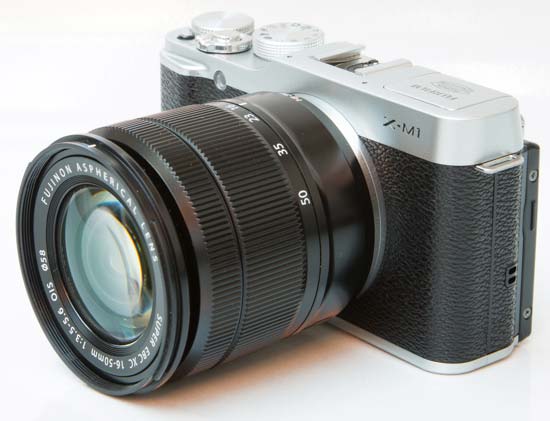 The Fujifilm XC 16-50mm F3.5-5.6 OIS lens attached to the Fujifilm X-M1 camera
The Fujifilm XC 16-50mm F3.5-5.6 OIS lens attached to the Fujifilm X-M1 camera
The overall build quality is good, in keeping with the X-M1 body that it ships with. The Fujifilm XC 16-50mm F3.5-5.6 OIS lens has a plastic mount and barrel, plastic focus and aperture rings, and a non-rotating 58mm filter thread. The zoom ring is fairly wide and has a ridged, rubberised grip band. Zooming is not internal, meaning the length of the lens changes while you zoom. Physically the lens is shortest at 16mm and longest at the 50mm setting.
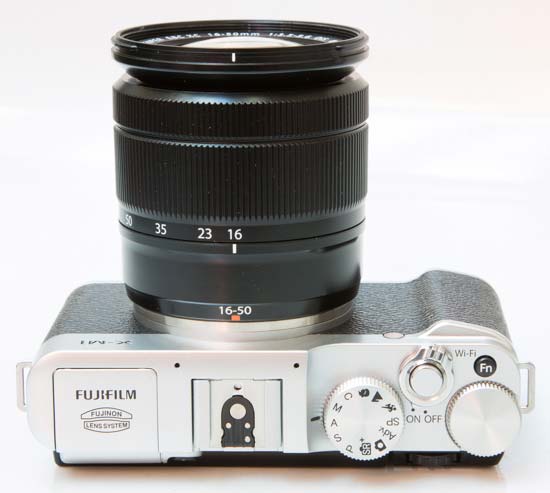 Top of the Fujifilm XC 16-50mm F3.5-5.6 OIS lens
Top of the Fujifilm XC 16-50mm F3.5-5.6 OIS lens
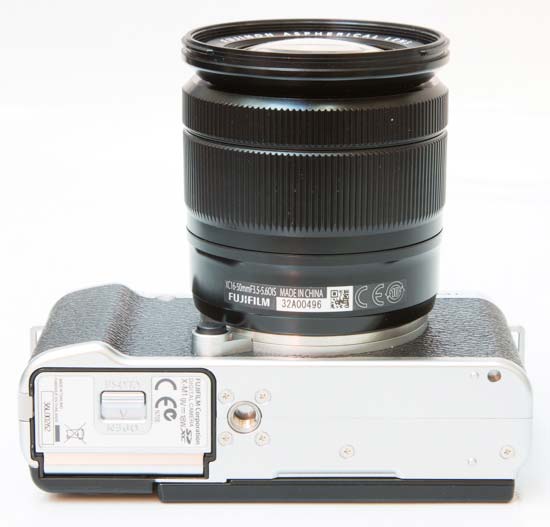 Bottom of the Fujifilm XC 16-50mm F3.5-5.6 OIS lens
Bottom of the Fujifilm XC 16-50mm F3.5-5.6 OIS lens
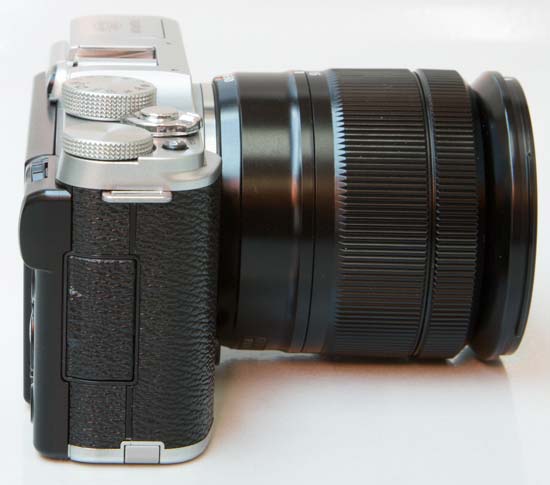 Side of the Fujifilm XC 16-50mm F3.5-5.6 OIS lens
Side of the Fujifilm XC 16-50mm F3.5-5.6 OIS lens
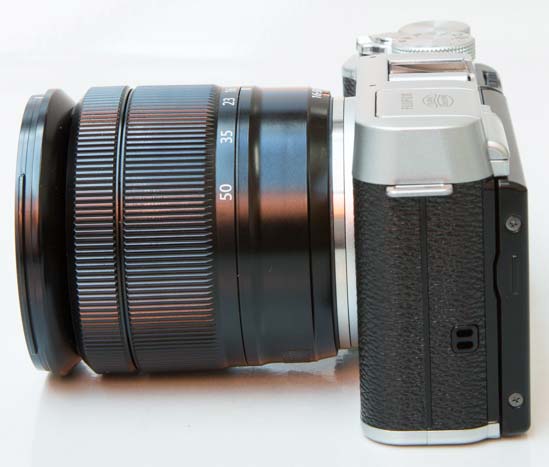 Side of the Fujifilm XC 16-50mm F3.5-5.6 OIS lens
Side of the Fujifilm XC 16-50mm F3.5-5.6 OIS lens
Both the zoom and the focus rings are smooth in action without being loose. Zoom creep is not an issue. The focus ring is a little narrow and has no “hard stops” at either end of the focus range.
The Fujifilm XC 16-50mm F3.5-5.6 OIS lens doesn't have a traditional aperture ring on the lens barrel. Instead the aperture is set via the camera body, so X-Pro1 and X-E1 must update their camera body's firmware to enable aperture adjustment via the camera's command dial.
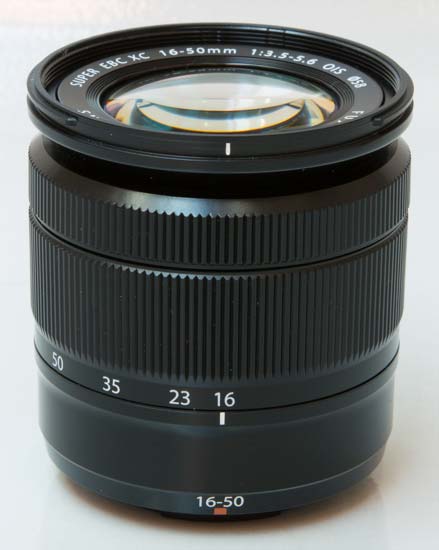 The Fujifilm XC 16-50mm F3.5-5.6 OIS lens, zoomed in
The Fujifilm XC 16-50mm F3.5-5.6 OIS lens, zoomed in
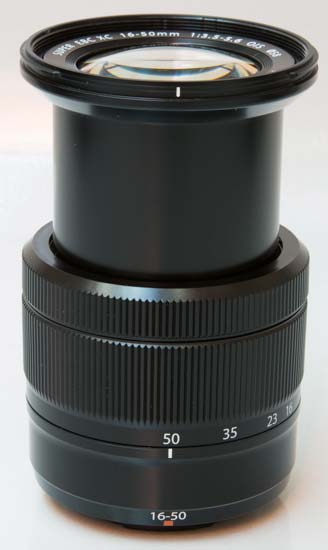 The Fujifilm XC 16-50mm F3.5-5.6 OIS lens, zoomed out
The Fujifilm XC 16-50mm F3.5-5.6 OIS lens, zoomed out
The Fujifilm XC 16-50mm F3.5-5.6 OIS has a built-in OIS (Optical Image Stabiliser), which is turned on and off via the camera's main menu system.
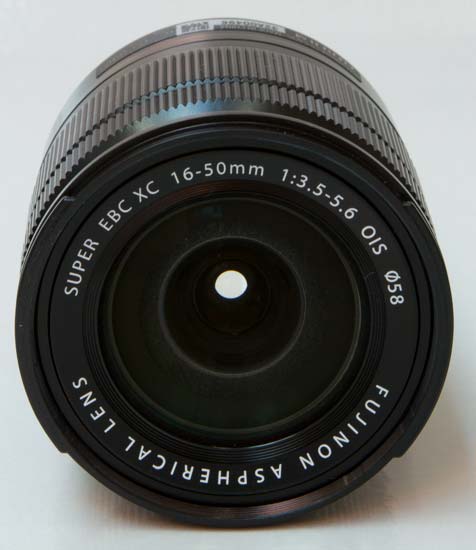 Front of the Fujifilm XC 16-50mm F3.5-5.6 OIS lens
Front of the Fujifilm XC 16-50mm F3.5-5.6 OIS lens
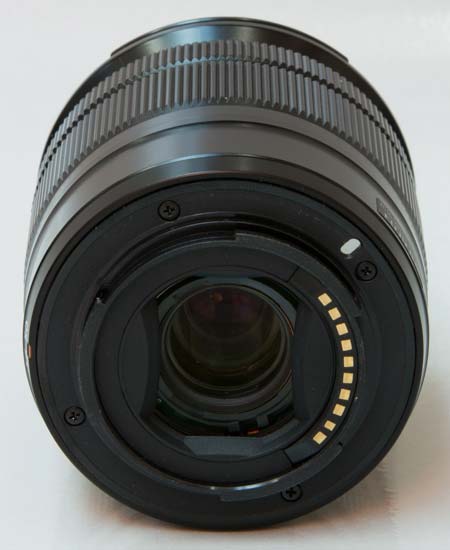 Rear of the Fujifilm XC 16-50mm F3.5-5.6 OIS lens
Rear of the Fujifilm XC 16-50mm F3.5-5.6 OIS lens
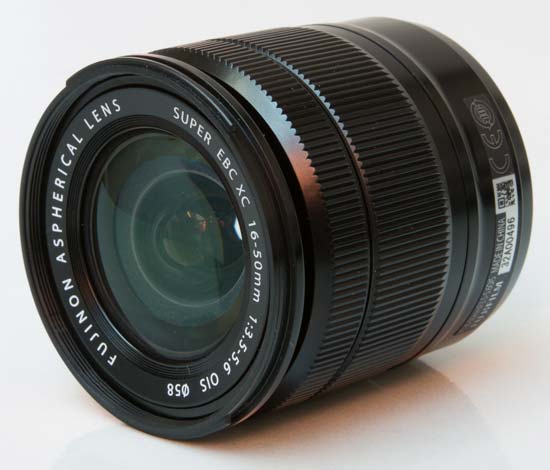 Front of the Fujifilm XC 16-50mm F3.5-5.6 OIS lens
Front of the Fujifilm XC 16-50mm F3.5-5.6 OIS lens
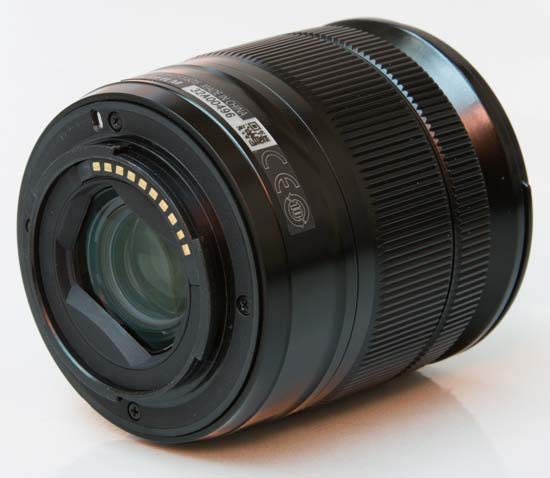 Rear of the Fujifilm XC 16-50mm F3.5-5.6 OIS lens
Rear of the Fujifilm XC 16-50mm F3.5-5.6 OIS lens
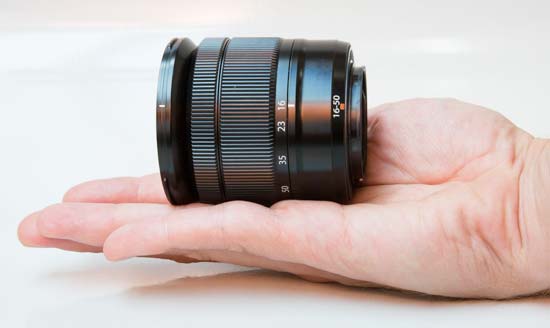 The Fujifilm XC 16-50mm F3.5-5.6 OIS lens in-hand
The Fujifilm XC 16-50mm F3.5-5.6 OIS lens in-hand
In terms of accessories, the lens ships with only lens and mount caps - there is no hood or bag.
Focal Range
At the 16mm end of the zoom range, the Fujifilm XC 16-50mm F3.5-5.6 OIS lens has a wide angle of view of 83.2 degrees.
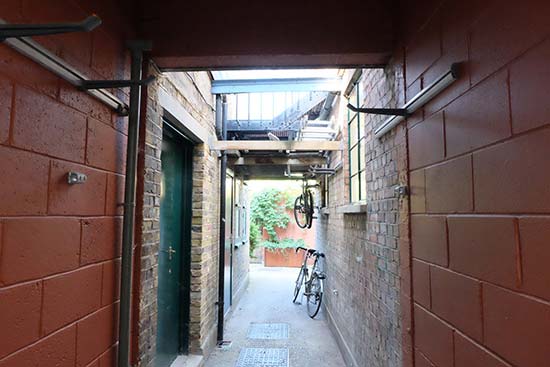 Field of view at 16mm
Field of view at 16mm
At the 50mm end, the angle of view narrows to 31.7 degrees.
 Field of view at 50mm
Field of view at 50mm
Distortion
At the wider end, the Fujifilm XC 16-50mm F3.5-5.6 OIS has some very slight barrel distortion, as you can see in the photo below.
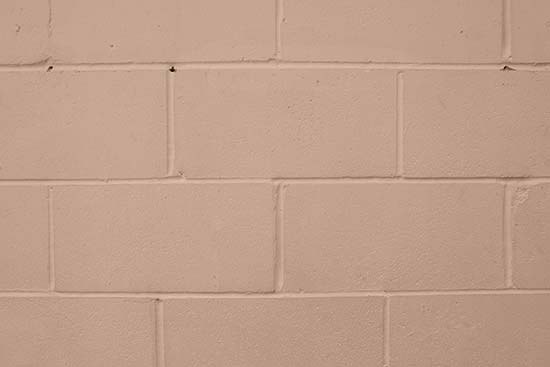 Distortion at 16mm
Distortion at 16mm
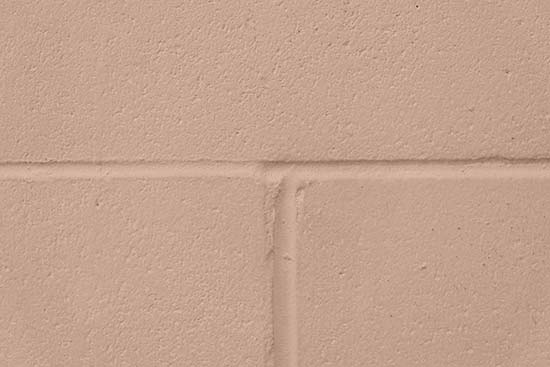 Distortion at 50mm
Distortion at 50mm
Focusing
The Fujifilm XC 16-50mm F3.5-5.6 OIS lens has a high-precision stepping motor. In practice, we found the auto-focus to be fast, very quiet and without too much hunting in low-light. The front of the lens does not rotate on focus, which is very good news for anyone looking to use the lens in conjunction with a polariser or graduated neutral density filter.
Chromatic Aberrations
Chromatic aberrations, typically seen as purple or blue fringes along contrasty edges, are not really a problem with the Fujifilm XC 16-50mm F3.5-5.6 OIS lens, with some limited fringing apparent in areas of high contrast.
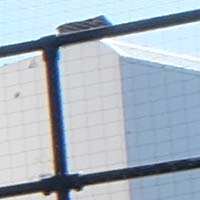 |
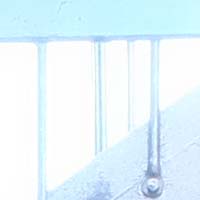 |
Macro
The Fujifilm XC 16-50mm F3.5-5.6 OIS is not a macro lens. The close-focus point is at 30cm from the sensor plane at 16mm and 40cm at 50mm, and the maximum magnification is 0.15x at full telephoto. The following example illustrates how close you can get to the subject, in this case a CompactFlash card.
 Close-up performance
Close-up performance
Bokeh
Bokeh is a word used for the out-of-focus areas of a photograph, and is usually described in qualitative terms, such as smooth / creamy / harsh etc. Fujifilm have paid attention to this aspect of lens use, employing a 7-segment diaphragm with rounded blades for pleasing bokeh. In our view, their efforts have been fairly successful - see the examples below.
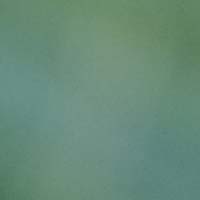 |
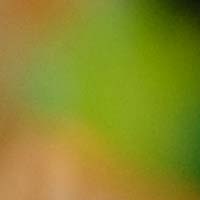 |
 |
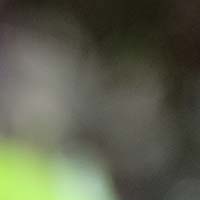 |
Sharpness
In order to show you how sharp this lens is, we are providing 100% crops on the following pages.
-
Ease
of Use -
Sample
Images -
Lens
Specs -
Rating &
Conclusion -
Main
Rivals -
Review
Roundup - Comment
